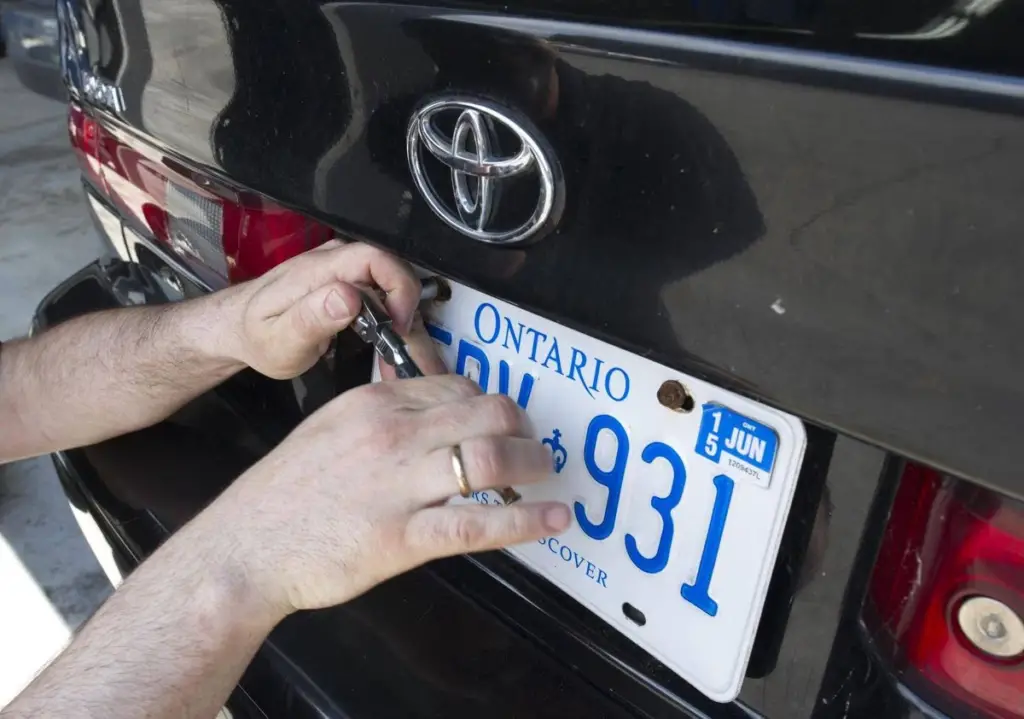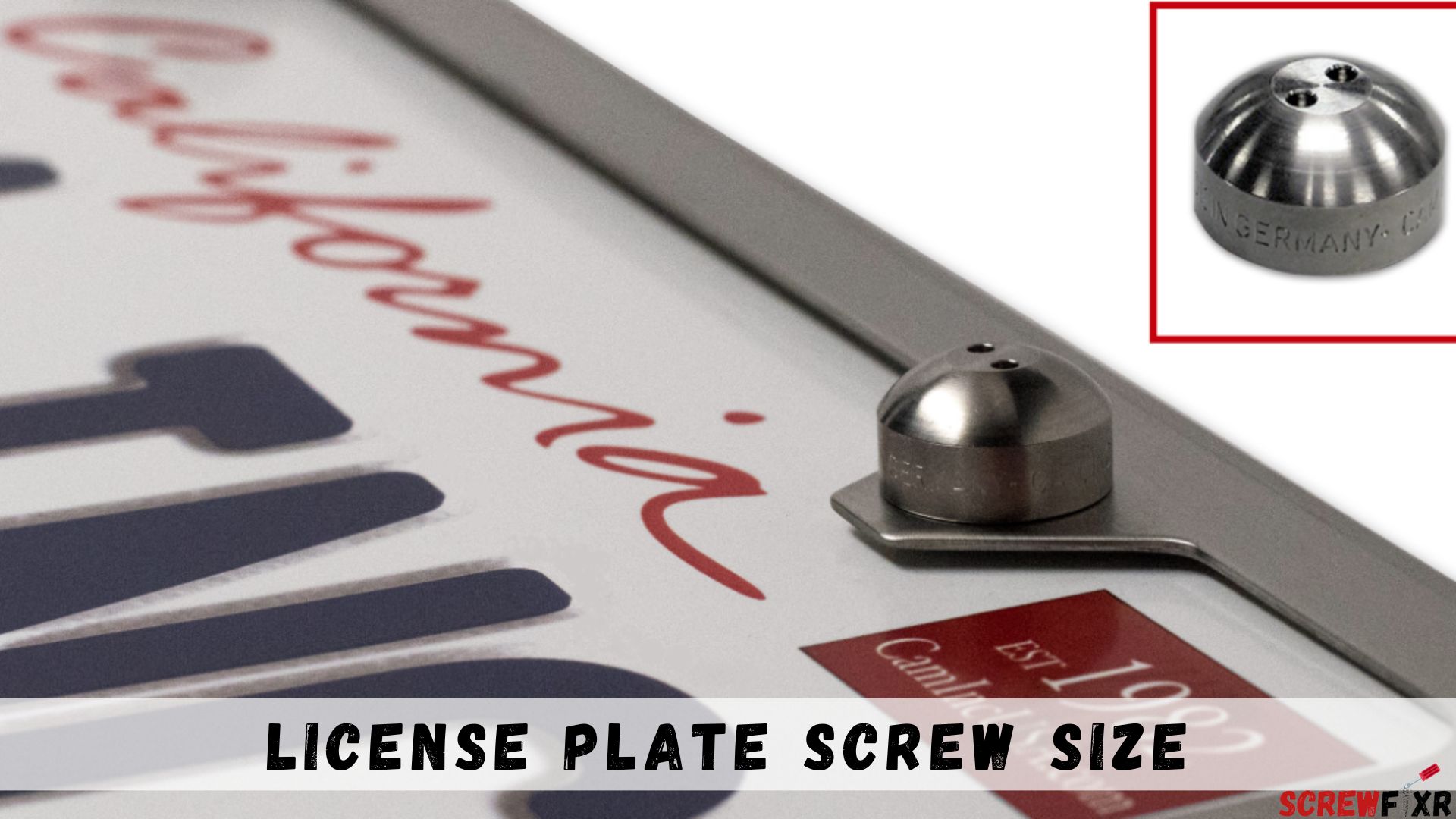When it comes to license plate installation, one crucial aspect that often goes overlooked is the size of the screws you use. License plate screw size may seem like a minor detail, but it can have a significant impact on the overall security and appearance of your license plate. In this comprehensive guide, we will delve into every aspect of License Plate Screw Size, ensuring that you have all the information you need for a successful license plate installation.
License Plate Screw Size: An Overview

Before we dive into the nitty-gritty details, let’s start with the basics. License plate screw size refers to the dimensions of the screws used to attach your license plate to your vehicle. While it may not be the most glamorous aspect of car ownership, it plays a crucial role in ensuring your license plate stays securely in place.
Why Choosing the Right License Plate Screw Size Matters

When it comes to license plates, the size of the screws may seem like a minor detail, but it plays a crucial role in ensuring your plate stays securely attached to your vehicle. Here’s why it matters:
Ensuring Secure Attachment
- Preventing Theft and Vandalism
License plate theft is a common problem that can lead to various issues for vehicle owners. Thieves often target license plates because they are relatively easy to steal. Choosing the right screw size can make it significantly more difficult for potential thieves to remove your license plate. When you use the correct screws, it becomes a deterrent, reducing the risk of your plate being stolen.
- Avoiding Plate Loss on the Road
Driving on the road can subject your vehicle to various forces, including wind resistance and vibrations. If you use the wrong size screws or if they are not properly tightened, your license plate may become loose and eventually fall off while you’re driving. This not only poses a safety hazard to you and other drivers but also means you’ll need to replace your license plate, incurring additional costs and inconveniences.
Complying with Legal Requirements
- State-Specific Regulations
Different states and countries have specific regulations governing license plates, including the type and size of screws that are permissible. Using the wrong size screws can put you in violation of these regulations, potentially leading to fines or penalties. To avoid legal trouble, it’s essential to be aware of and adhere to your local laws regarding license plates.
- Avoiding Fines and Penalties
Failure to comply with license plate regulations can result in fines and penalties. Law enforcement agencies often conduct routine checks to ensure that vehicles are in compliance with these regulations. If your license plate does not meet the required specifications, you could face fines and may be required to correct the issue promptly. Choosing the correct screw size is a simple but effective way to avoid these unnecessary expenses and legal consequences.
Different License Plate Screw Sizes
let’s explore the common license plate screw sizes:
- Standard License Plate Screw Size
The standard license plate screw size in the United States is typically #14 x 3/4 inch. These screws are compatible with most license plates and vehicles. They offer a good balance between security and ease of installation.
- Metric License Plate Screw Size
In countries that use the metric system, the equivalent of the standard US screw is often M6 x 20 mm. It’s essential to check your vehicle’s specifications to ensure compatibility with metric screws.
- Security License Plate Screw Size
For added security, you can opt for security screws, which require a specialized tool for removal. These screws come in various sizes, such as #14 or M6, and are an excellent choice if you’re concerned about theft.
How to Choose the Right License Plate Screw Size

Selecting the appropriate screw size for your license plate is relatively straightforward:
- Check Your Vehicle’s Specifications: Refer to your vehicle’s manual or consult the manufacturer’s guidelines for recommended screw sizes.
- Consider Security: If security is a concern, opt for security screws.
- Measure Carefully: If in doubt, measure the existing holes on your license plate bracket to determine the correct size.
Installing License Plate Screws
Now that you have the right screws in hand, let’s walk through the installation process:
- Gather Your Tools: You’ll need the appropriate screws, a screwdriver or drill, and possibly a wrench for security screws.
- Align Your License Plate: Position the license plate over the bracket, ensuring it’s straight and secure.
- Insert the Screws: Insert the screws through the license plate holes into the bracket holes.
- Tighten Securely: Use your screwdriver, drill, or wrench to tighten the screws until the license plate is snug and secure.
- Check for Stability: Give your license plate a gentle shake to ensure it doesn’t wobble.
Maintenance and Care Tips
To ensure that your license plate remains secure and in good condition, it’s essential to perform regular maintenance and care. Here are some key steps to consider:
Cleaning and Rust Prevention
License plates are exposed to various environmental elements, which can lead to dirt accumulation and even rust over time. To keep your license plate looking its best and to prevent corrosion, follow these cleaning and rust prevention tips:
- Regular Cleaning:
- Use a mild detergent and water to clean your license plate periodically.
- Avoid harsh chemicals or abrasive materials that could scratch the surface.
- Wax Application:
- Apply a car wax or protective coating to the license plate to create a barrier against moisture and contaminants.
- Reapply the wax as needed, especially after washing your vehicle.
- Rust Prevention:
- If you notice any signs of rust on the screws or the plate itself, address it promptly.
- Remove rust using a rust remover or rust converter and repaint the affected areas to prevent further corrosion.
Periodic Inspection for Tightness
Ensuring that your license plate remains securely attached is vital to prevent theft and loss. Perform regular inspections to check the tightness of the screws and the overall condition of the license plate attachment:
- Visual Inspection:
- Examine the license plate screws and their surrounding areas for any signs of wear, damage, or loose parts.
- Ensure that the license plate is still properly aligned and not crooked or hanging loosely.
- Tightening Screws:
- If you notice any loose screws, use the appropriate tools to tighten them securely.
- Be cautious not to overtighten, as this can damage the plate or its attachment points.
- Replace Worn Parts:
- If screws or other hardware show signs of wear, consider replacing them with new ones.
- Inspect the condition of the license plate frame, as well, and replace it if it’s damaged.
- Recheck After Significant Journeys:
- If you’ve been on a long road trip or have driven in adverse conditions, it’s a good practice to recheck the license plate’s attachment to ensure it hasn’t loosened due to vibrations or environmental factors.
By following these maintenance and care tips, you can prolong the life of your license plate, keep it looking pristine, and ensure that it remains securely attached to your vehicle, reducing the risk of theft or loss.
Frequently Asked Questions

Can I use any screws for my license plate?
While you can technically use different screws, it’s advisable to stick with the recommended sizes for security and stability reasons.
How often should I check my license plate screws?
Regularly inspect your license plate screws for tightness and signs of wear, especially after car washes or extreme weather conditions.
Are security screws necessary?
Security screws add an extra layer of protection against theft, making them a wise choice if you’re concerned about license plate tampering.
Can I use adhesive instead of screws?
While adhesive may work temporarily, screws are the more secure and reliable option for long-term use.
What if my license plate holes don’t match the screw size?
If your license plate holes don’t align with the screw size, consider using a bracket adapter or drilling new holes.
How do I remove security screws if needed?
To remove security screws, you’ll need a matching specialized tool that fits into the screw’s unique pattern.
Conclusion
License plate screw size may not be the most exciting topic, but it’s undeniably essential for your vehicle’s security and aesthetics. By selecting the right size and following proper installation procedures, you can ensure your license plate stays in place, adding a touch of style to your vehicle while maintaining its security.


